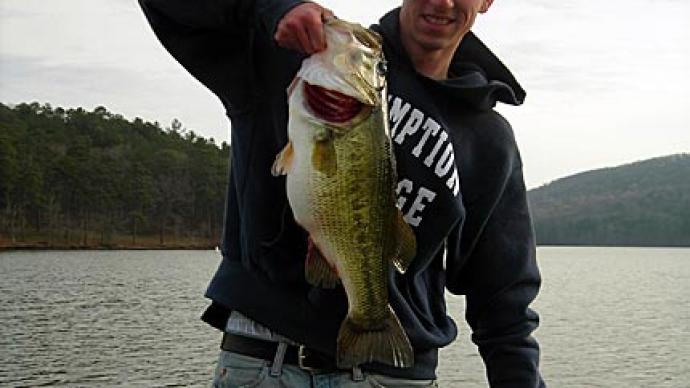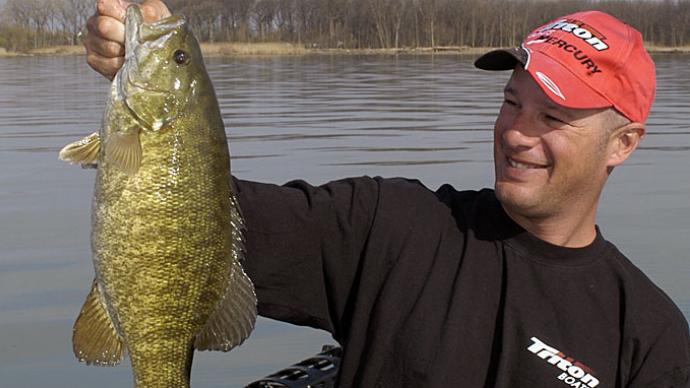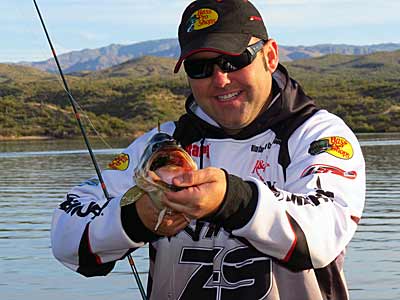
Prespawn bass have a notorious reputation for being hard to catch, but fortunately not all bass in a lake spawn simultaneously. This means that in early spring, you’ve got fish that are still deep, some that are moving up, and maybe even some already making beds and getting ready to rock and roll. These fish may be catchable, and some of the best fishermen I know choose baits that can be worked at various depths at this time of year.
Dart Head + Floating Worm
Back in the day, the big bait out west was the Westy Worm. This was a super floater worm on a light jig with a very light straight-shank worm hook – the gold kind that straightens out easily. A second gold hook was rigged near the worm's tail, attached to the first hook with mono. John Murray says he thinks that even after all these years, he’s still caught more fish on a Westy than any other lure.
The super floater worm made the Westy so good – that worm would stand up from the bottom even with that second hook because the hook was so light. The Westy with the light (3/16) head was the most popular, and you’d fish it on spinning gear. The heavier ones, about 3/8-ounce, were good at first light and for aggressive fish. For those heavier ones, you can use a baitcaster. You can fish a little jig head with a floating worm at just about any depth – you can even flip or pitch it, and it’s perfect for working down a bluff, a bank, a long point, or riprap. You drop the rig, let the line go slack, then reel until the line is taut. Move the worm by either reeling a bit if you’re on the bottom or giving it a little hop, then letting it settle again if you’re fishing down a bank or some riprap.
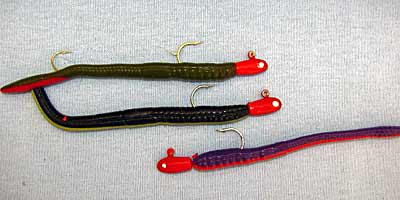
A rig very like a Westy is easy to make – just put a floating worm on a dart head or pea head. If you want to go to the trouble of adding that back hook, you can certainly do so. The hookset is the key to successfully fishing with thin hooks. The hooks practically set themselves, but since they also straighten out very quickly, it’s crucial to use a reel set instead of swinging on the fish. When fluorocarbon line came out, it was unanimously declared to be the best thing ever happened to Westy fishing because you could feel the bait and set the hook easily, even very deeply.
If you start to drag or hop the rig and it feels heavy, like you hooked a rubber band, just reel while pulling back on the rod simultaneously - without jerking it or pulling too hard. The gold hook will slide in so easily it’s like magic. Don’t try to horse a fish on this rig – play him out and let him run if he wants to. Most Arizona-born pros have caught their biggest fish on a Westy, and it takes a while to boat those bad boys. Use a net to get him to the boat, or get down there and lip him. You’ll never swing him over the side with that hook.
Because of the open hook, the rig can get hung up now and then. Shake it on a slack line, and it will usually come free. If it doesn’t come out, a steady pull will straighten the hook out, and you can get your rig back and not have to re-tie. Use your pliers to bend the hook back into shape, touch up the point, and you’re ready to roll.
Shaky Worm
Shaking a worm is a good technique whenever fish are deep – summer to fall, and into prespawn. After a cold front, the deep fish are more predictable because they aren’t as affected by weather changes at depth. If the fish relate to structure, they are usually catchable no matter the weather. Take a small, straight-tail worm, and Texas rig it on a 3/16-ounce weight if the fish are over 30 feet deep. If they are shallower than that, you can use a 1/8-ounce weight. Black weights are best – we paint brass weights black with model paint.
This is a clear-water technique so use clear line like fluorocarbon or clear mono. You can add a glass bead if you want it to be more of a doodling technique. Use a 7'1" medium-fast action spinning rod and a reel that will take up line fast. This shaky worm technique works best fished vertically – if there is a bow in the line, it can be hard to get a good hookset. Use a 1/0 fine wire straight worm hook – straight ones set faster, but you can use an offset hook if you’re fishing a fatter worm. Rig the worm, so it hangs perfectly straight.
Fish this when sitting over creek channels, roadbeds, or underwater structures. If you want a shaky rig that you can use horizontally, try the same rig with a lead weight, a clear bead, and a curly tail worm. Make long casts with this rig, fish it like a Senko – two twitches, then two more, etc. Keep reeling the whole time. The bite is just weight; you can’t stop moving it: sweep and keep reeling—cast way to the front or back as you fish and keep sweeping. Never let the rod go past the middle of your body, or you’d have to stop to set the hook. You want to keep the sweeping motion going, and you should barely shake the rod as you go. You’ll be able to feel the weight and the bead hitting, and then suddenly, you won’t. Those are usually the bigger fish. Little tap-taps are generally smaller fish. With this technique, you can fish down the bank and catch fish the guy ahead of you missed.
Glide Baits
We went to Arizona’s Saguaro Lake with Nitro Pro Matt Shura one February, which is pre-spawn in the desert. He was catching fish everywhere from five to fifty-five feet deep. “This time of year, they can be anywhere,” Matt told us. He loves flats with a good drop-off this time of year, and he found a good one that ran out into the lake before dropping off to thirty feet in the channel. There’s a tree on the break line – Matt calls it the “magic tree.” He visits it several times a day this time of year and stays a cast away.
You could sit there all day and not get a bite for an hour, then suddenly you and your partner will both get a bite, he says. The key for this time of year is to go slow. He’ll often use a drop shot or dead-stick a Carolina Rig, but one of his secret weapons is a tiny glide bait – the Rapala Jigging Rap. This tiny bait swims in little circles when you lower it down, and with hooks fore and aft, you hook them no matter which end they grab.
We’ve also had good luck with glide baits on steep structures like bluffs, cliffs, pilings, etc. Glide baits like the Storm Arashi sink slowly at a bit of an angle, headfirst. We fish them on spinning gear, and the slightest movement of a rod or line gives them to action. If you snap the line, they’ll turn around – we throw the shad-colored Arashi’s on the cliffs and catch fish at about any depth. The key is to be patient and let the lure fall. If it gets onto a ledge, pull it off and let it keep falling. These things are killer on pre-spawn bass.
Tubes
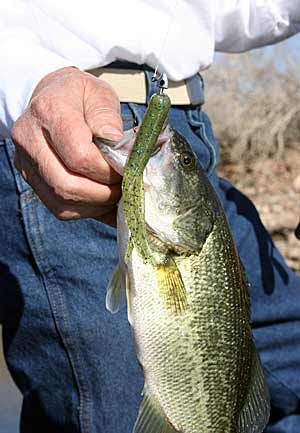
Gary Dobyns says that tubes are his go-to technique when conditions are tough. He got away from them for a while, even though he fished a LOT of tubes early on, but then during a big tournament, he noticed a guy fishing behind him who was catching a ton of fish he was missing. That guy was fishing a tube bait.
There are several ways to fish a tube. Dobyns likes green pumpkin, watermelon, and shad colors and fishes them up to 55 to 60 feet deep. He also swims them a lot for suspended fish. Ninety-nine percent of the time, he fishes a tube on a dart head with the head exposed. Depending on how aggressive the fish are, he’ll use 1/8-, 3/16-, or ¼-ounce dart heads. The more aggressive the fish are, the heavier the head and the faster the movement.
The tube on a dart head is also his number one “fun fish” bait because you can catch a ton of fish less than five feet deep with a ¼-ounce weight. If he’s fishing grass or weeds, he’ll switch to an internal Fat Gitzit lead jig. Another thing Gary likes about tubes is the variety of sizes you can get: from 2-1/2 to 4 inches, and even up to giant 10-inch Canyon Lures Tora Tubes. If you want to add scent, you can put it inside the tube, making it easier to slide a weight inside.
These are excellent lures for suspended fish. After spotting suspended fish on his graph, Dobyns casts out past the fish, counts the bait down, then swims it back while bouncing the rod tip. “They eat it good,” he says, “so you get great hooksets.” He uses spinning or casting gear, depending on the weight and size of the tubes he’s using. He says tubes are also the perfect craw imitation – think of it as a down-sized jig. Just drag it, shake it a little, and make it look like a craw. This was a winning strategy for him whenever he was fishing in a tournament where the weather was cold and miserable. Even with a serious north wind and a cold front, tubes let him lead the first day at an Oroville tourney and won him a boat. “The only reason I won that boat was a tube,” he says.
Rip Baits
You can’t mention the name Gary Dobyns without talking about rip baits. Gary is known for being a power fisherman, even in the worst conditions. He says his first recollection of throwing a jerkbait was when he was a kid, using floating Rebels and Rapalas for bass and trout. He fished them with a 1-2-pause, 1-2-pause cadence, and fished ponds and sloughs.
Dobyns says that the first time he knew of anyone else fishing them was when he learned about Jimmy Crisp fishing them on desert lakes. He called it “Crispin’” and used a long spinning rod and big, long sweeps in a sweep-pause-reel cadence. In 1983 when Dobyns himself started fishing tournaments, they were established baits. The bigger baits were fished with long sweeps, called ripping. Twitching was done with the smaller topwater and shallow jerkbaits.
Jerkin’ is what Dobyns likes to do now, fishing with shorter, harder pops. Twitching, he says, is very effective in pre- and post-spawn. If he’s not getting bit, he varies his pause before he changes techniques.
Gary learned the same we do today – reading articles. He started ripping with big spinning stuff, which eventually evolved into jerking with baitcasting gear which he found easier and more comfortable. Back in the day, he’d use the flashiest baits he could find, like a Bomber Long A in solid chrome or a Smithwick Clown Rogue. The Rogue was his favorite, and he’d order them straight from the factory because he couldn’t find them in stores.
Nowadays, he uses more natural colors or even transparent colors. The rod you use is an essential part of the technique. It should load up but not react too quickly. It needs to be forgiving when you set the hook, which is why fiberglass used to be his favorite - but those are incredibly heavy and tiring.
Gary says he loves the Pointer jerkbaits and fishes them on 10- or 12-pound-test P-Line. Any heavier and you don’t get the depth, and any lighter gives you too much stretch. A fast reel is a must; otherwise, you spend too much time catching up on the pause – you want to crank a couple of times to be caught up.
During prespawn, he starts with a deeper running bait and catches many fish deeper than ten feet. As things warm up, he gradually shifts to the shallower-running baits. After spawning, the fish are more active and react to smaller, more erratic baits.
Don’t let yourself get psyched out by the idea of pre-spawn bass. Those bass are on the move and hungry as the water starts to warm up after a long winter. You never know where you’ll find them this time of year, so try one of these techniques that will let you cover a range of depths with one rod.
BassResource may receive a small portion of revenues if you make a purchase using a link above.


